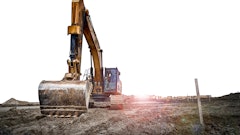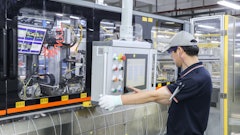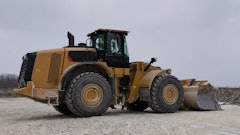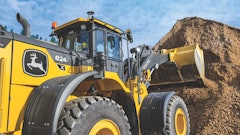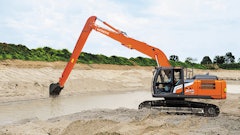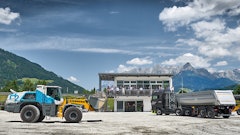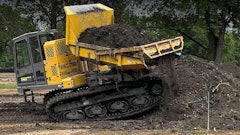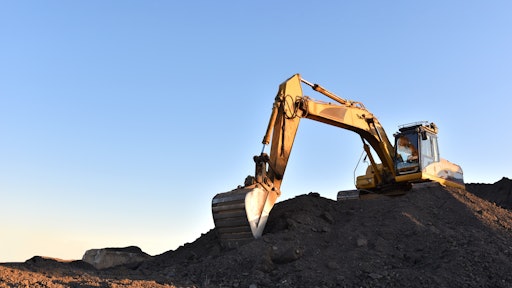
Every year, Roland Berger conducts a global study on public companies in the Capital Goods space — which includes construction equipment manufacturers and suppliers — based on our “Winners” framework, a diagnostic tool to assess historic performance and derive implications for future strategy development and execution.
Decades of project work with industrial companies shows that financial markets reward risk-adjusted profitability (i.e., the average return on invested capital net of the average cost of capital) combined with real growth in invested capital. “Winners” are companies that place in the top right-hand quadrant of our framework. Historically, such players have achieved superior shareholder return performance.
2023 turned out to be a relatively strong year for the Capital Goods industry, recording around 5% top-line growth. True, that was down on the 8% plus growth rates in 2021 and 2022, but the growth in 2023 was also much less driven by the catch-up effect following the pandemic. Growth in 2023 was the result of the industry's ability to sustain the price levels that had recently been established. Other important contributors to growth were government incentive programs and public investment, such as the U.S.'s Inflation Reduction Act, which helped buoy and level real volume demand.
 Capital Goods revenue developmentRoland Berger
Capital Goods revenue developmentRoland Berger
Even more impressive is the fact that the industry was able to increase its profitability by more than 1% compared to 2022, pushing up earnings before interest and taxes (EBIT) to 10.2% and earnings before interest, taxes and amortization (EBITDA) to 14%. Both these figures are higher than prepandemic levels. Capital goods players, in addition to sustaining price levels, successfully passed on material price increases to customers and improved supply chain efficiency. High interest rates presented a unique challenge to the industry in 2023.
 Capital Goods profitability developmentRoland Berger
Capital Goods profitability developmentRoland Berger
No surprise, then, that invested capital grew slower than revenue and profitability in 2023. Yet, the companies we call "Winners", despite being fewer in number than other players, are responsible for 65% of the total growth in invested capital in our dataset. Compared to 2020, Winners have increased their invested capital by around 40%, while other players saw a decrease of 5% overall. This confirms the resilience of the Winners and their ability to continue to build for the future, despite a challenging overall economic environment. They also enjoy a consistently lower debt-to-equity ratio, remaining at approximately 0.6 since 2019, while other players have only recently started to come back down to their prepandemic levels (the group we call "cash generators" are closest, at around 0.7 in 2023).
How does this picture differ regionally? The overall strength of the North American economy is visible in our results. Thus, while other regions have lost Winners, North America has held steady. China, affected by the challenging economic environment, has seen elevated growth rates compared to other regions but the slowdown in growth here is also visible in our results. Europe experienced slower gross domestic product (GDP) growth due to lower consumer spending and elevated energy prices but overall, its capital goods players have proven resilient. In the short-term future, we expect a year of continued top-line growth, albeit at a slower pace. Uncertainty about outcomes will remain, driven by factors such as geopolitical tension and ongoing conflicts.
 Regional distribution of resultsRoland Berger
Regional distribution of resultsRoland Berger
2024 will also see many elections with global implications, including the U.S. presidential elections, elections to the European Union Parliament and to the Indian Lok Sabha (lower house of Parliament). Central-bank decision timelines on interest rates will likewise affect the economy. And it remains to be seen if the currently high price levels that contributed to the 2023 results will be sustainable in the long term. However, we expect weakening inflationary pressure in Europe and the ramp-up of infrastructure programs in North America to help support growth.
Winners will likely enjoy a particularly advantageous position due to their strong balance sheets and the investments they have made in the current environment. Other players will be limited in terms of making capital investments due to the now higher interest rate levels. By continuing to make investments, Winners can thus put even more space between themselves and their competitors. The mid- to long-term future remains difficult to predict, due to the many sources of uncertainty. In 2025 and beyond, as in 2024, Winners will continue to benefit from the investments that they are able to make while others cannot. They also stand to benefit from a first-mover advantage in new technologies, such as artificial intelligence (AI), advanced robotics and next generation manufacturing.
Technologies like these will continue to mature and generate significant gains in efficiency and productivity for those that adopt them. This combination of advantages — having the resources to expand, plus early investment in productivity boosting technology — is something that Winners should capitalize on.
 Results by sectorRoland Berger
Results by sectorRoland Berger
For the construction equipment sector, 2023 was marked by significant challenges, amid a severe downturn in building construction and increased geopolitical tension. In Q4, the overall market showed little to no growth, or even declined, in most regions. North America and Asia, excluding China, saw only marginal upticks, attributed to a delay in fleet replacement amid elevated interest rates, inflation and cautious behavior among end customers. China saw the largest fall, largely due to slower economic activity.
That being said, several large players had strong years driven by their global reach which allowed them to spread risk and their ability to sustain increased prices levels, while supply chain cost pressures started to ease. Over the period since 2019, the sector as a whole shows up in the Winners quadrant; a testament to the industry’s overall relevance, resilience and ingenuity in dealing with a challenging environment with several black swan events at once.
Looking forward, these same qualities will continue to be required. Global construction activity is expected to remain dampened in 2024, with some potential uplift in the second half of the year especially in the U.S., driven by high inflation and interest rates. The housing crisis in China will further reduce demand for construction, especially in the residential sector. A potential uptick in nonresidential construction is expected to drive demand mainly for larger machinery.
In the longer term, growth will come from increasing investment in electrification and alternative fuel solutions, starting with the electrification of compact equipment. An increase in the adoption of new business models is also likely, such as equipment-as-a-service and service offerings. The many Winners within the construction equipment sector certainly have a good starting position to embrace and capitalize on new technologies to continue to be successful going forward.




